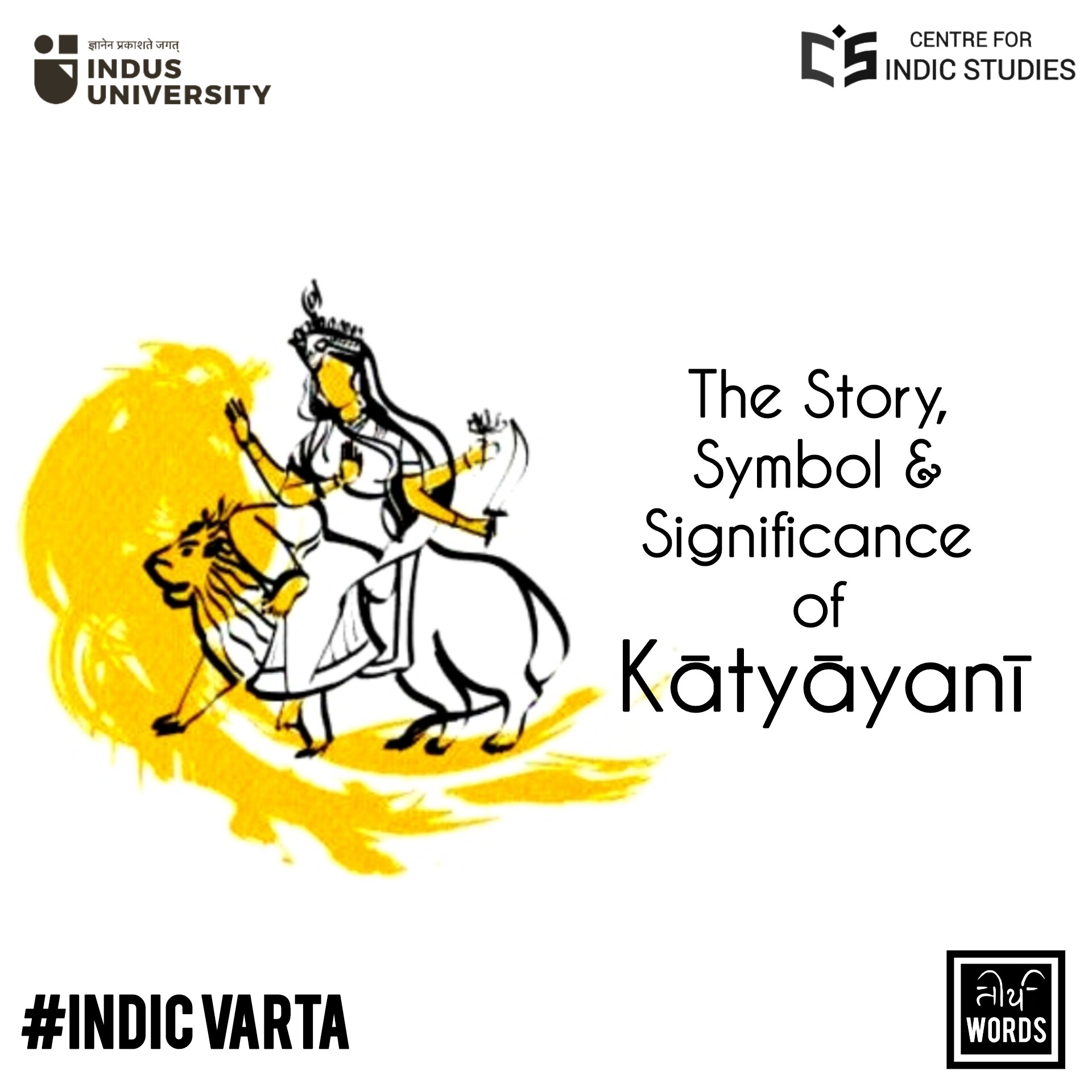- Visitor:176
- Published on: 2024-10-08 01:59 pm
The Story, Symbol, and Significance of Kātyāyanī
Goddess Kātyāyanī is the symbol of daughterhood whereas Kātyāyana serves as the symbol of paternity. As the devī herself chose the sage as her father, the latter is hailed as one of the greatest patriarchs of all time in the history of mankind. In the sacred culture of the Sanātana Dharma, even patriarchy stems from parenting and protecting the universal feminine!

Story
Now, that Skandamātā was euphoric to have her son, it is to be noted that there was a time when she was born as a daughter too, other than her reincarnation as Śailaputrī. In ancient Bhārata, there lived a revered sage named Kātyāyana, known for his deep wisdom and spiritual insight. A dedicated brahmacārī, he embraced the path of perpetual celibacy, finding strength and clarity in solitude. Residing in the tranquil forests, he cultivated a profound connection with nature, living simply amidst the trees and rivers. Every day, he diligently performed elaborate rituals of yajña, offering sacred oblations with utmost purity. Through his disciplined lifestyle and unwavering devotion, Kātyāyana became a beacon of spiritual wisdom, attracting seekers from distant lands who sought his guidance and blessings.
He had attained mokṣa and desired nothing, yet he felt lonelier and lonelier as he grew old. One fine morning, he was contemplating upon the sacred form of the Ādiśakti when a thought flickered through his mind: How about having the devī herself as a daughter? What could give more joy to a celibate man than having the goddess whom he worshipped as his little daughter? So, he prayed to the divine feminine to incarnate in the form of his daughter.
Meanwhile, once lord Śiva was lecturing to his followers upon the illusory nature of the world. In that discourse, he depicted the triviality of the materialistic world. Expatiating upon the fact, he told his followers that true wisdom comes in ditching the illusory materialistic world and entering into the realm of spirituality. Now, as he was saying all these, his wife, Pārvatī, who represented all the materialistic phenomena, was sitting beside him, infuriated. Surely, no wife likes to hear the truth that comes from her husband! Angry, she disappeared from the Mount Kailāśa, Śiva’s abode, and appeared as Kātyāyanī, the daughter of sage Kātyāyana, fulfilling his aspiration. Thus, not only she succeeded in punishing her husband for telling the truth, but also graced his devoted worshipper.
Once she left, there ran a hullabaloo in heaven and earth. For years, there grew no crops and grains, letting mankind to face starvation. Everyone on earth starved and was unfed for decades, except Kātyāyana. As the humans themselves had nothing to eat, they stopped performing yajñas and stopped offering to the deities. Together, they all went to Brahmā and Viṣṇu who convinced Śiva to visit sage Kātyāyana’s hermitage and enquire the reason of his materialistic prosperity even in that dire situation. Śiva visited the hermit’s dwelling disguised as a beggar. To his astonishment, he found that the daughter of Kātyāyana who came out of the home to offer him the alms was none other than his wife, Pārvatī, who had grown into a nubile damsel! Although Śiva had outgrown hunger, he had to beg for his followers’ sake. Fully fed, his followers rejoiced and addressed Kātyāyanī as mother ‘Annapūrṇā’, the one who is full of food and wealth. They implored their master to ask her hands in marriage.
Śiva revealed himself and also narrated to her of her true identity. Śiva apologized to her for the ‘wise and truthful’ words. Since that day, every husband has a sacred duty of apologizing before his wife even if he is not guilty. The lord proposed to her, but she sent him to her father, Kātyāyana, to seek his consent. The sage, who knew everything, was delighted to do the kanyādāna in their wedding. The goddess then decided to rebuild the city of Kāśī for the followers of her husband, blessing them with the promise that none in the city will ever sleep unfed!
Symbol
Whereas we see the joy of having a baby son in the form of Skandamātā, we relish the joy of having a daughter in the form of Kātyāyanī. Goddess Kātyāyanī is the symbol of daughterhood whereas Kātyāyana serves as the symbol of paternity. As the devī herself chose the sage as her father, the latter is hailed as one of the greatest patriarchs of all time in the history of mankind. In the sacred culture of the Sanātana Dharma, even patriarchy stems from parenting and protecting the universal feminine! One may narrate the tale to the ill-informed feminists when they dare to belittle the great tradition of this pristine land making too much of a fuss about patriarchy.
Secondly, one must not fail to notice how Śiva very humbly apologized to his wife despite the fact that what he spoke was true. This mature understanding coming from the emblem of manhood is another great example that debunks the notion of oppression of women in the traditional family affairs of the Sanātana Dharma. On the other hand, when Kātyāyanī easily forgave her husband but refused to be married again without her father’s consent, she made herself the symbol of daughterly loyalty.
Then again, in Kātyāyanī’s emergence into the form of a generous motherly figure as Annapūrṇā, she also epitomizes the role of a woman who can play a daughter and a mother concurrently, fulfilling both her duties in perfect balance.
Significance
Every woman who practises the Sanātana Dharma should take lessons on the ideals of daughterhood from the figure of Kātyāyanī whereas all the men should take cues from sage Kātyāyana that ancient Bhārata was perhaps the only place on earth where men prayed to have daughters and celebrated them equally as their male offsprings. It is a shame that the ‘India’ that we have made out of this ‘Bhārata’ suffers from the curse of female foeticide and female infanticide. To restore us back to greatness, calling up Kātyāyanī and taking lessons from her life are of extreme importance. On the sixth day of the Navarātri, one may worship her by chanting:
ॐ चन्द्रहासोज्जवलकराशाईलवरवाहना।
कात्यायनी शुभं दद्याद्देवी दानवघातिनी।।
स्वर्णाआज्ञाचक्रस्थितां षष्टमदुर्गात्रिनेत्राम्।
वराभीतकरां षगपदधरां कात्यायनसुतां भजामि॥
पटाम्बरपरिधानां स्मेरमुखीं नानालंकारभूषिताम्।
मंजीरहारकेयूरकिङ्किनिरत्नकुण्डलमण्डिताम्॥
।। ॐ देवी कात्यायन्यै नम: ।।
- 88 min read
- 5
- 0










